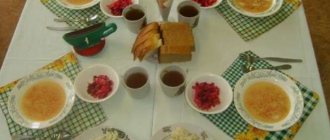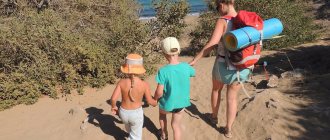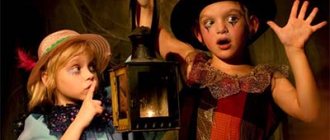List of pots (for the pearl group, etc.).
A beautiful template for the design of a list of potties for a kindergarten group.
Suitable for the design of the group “Pearl”, “Pearls”, as well as groups with other names.
If you have not found the list you need specifically for the name of your group, leave this one as a candidate. The presence of a shell and a pearl at the bottom of the background only decorates the catchy and bright background.
The list of potties can be entered in advance in a text editor, and then printed, or you can write the last and first name of each student with a serial number by hand using a pen on a pre-printed template.
Publications on the topic:
Interesting things in this section
List of lockers (group Zhemchuzhinki, etc.)
Background for the design of a general list of lockers in the preschool group. The list of children is entered on the computer.
List of toothbrushes (group Zhemchuzhinki, etc.)
Background for the design of a list of toothbrushes in a kindergarten group. Suitable for the group Pearls and.
List on the bed (gr. Pearls, etc.)
Background for the design of a list of beds in a kindergarten group. Suitable (as a standard) for the “Pearl” group or.
The list of kids for potties in kindergarten templates are blank.
Sudzhansky district, Kursk region
Layout of children at tables during meals
Publications on the topic:
Work experience “Development of speech in children of senior preschool age through the use of mnemonics” Dear colleagues, I would like to present to your attention my work experience. I would like to begin my speech with the words of a famous teacher:
Using the technique of joint drawing as a special method of teaching autistic children Joint drawing is a special gaming method. During joint drawing, the teacher draws an object or plot drawing that is close to the experience.
Abstract of the educational activity for children with mental retardation “Memorizing the poem by A. S. Pushkin “Winter” using modeling techniques” State budgetary preschool educational institution kindergarten No. 79 of a combined type in the Primorsky district of St. Petersburg.
Consultation for educators “Formation of a culture of behavior in preschoolers during meals” Nutrition culture in kindergarten Nutrition culture in kindergarten is a science necessary in modern life. Fast food that looks attractive.
Consultation “How to behave at the table so that the child always has an appetite and positive emotions during meals” How to behave at the table so that the child always has an appetite and positive emotions during meals. • Do not make comments at the table;.
Consultation “Organizing children’s nutrition and developing aesthetic eating skills. Culture of behavior at the table” Children’s health cannot be ensured without rational nutrition, which is a necessary condition for their harmonious physical growth.
OOD in mathematics “Independence of number from the spatial arrangement of objects. Mathematical riddle" OOD in mathematics on the topic: Independence of number from the spatial arrangement of objects. Mathematical riddle. Relationships between numbers.
Open lesson in the senior group “Use of the MMC technique when introducing children to objects of inanimate nature” Type of OD: Educational Direction: cognitive development Integration of educational areas: cognitive, social and communicative development.
Parent meeting “Etiquette during meals” I would like to start my speech with the folk truth: what you teach a child to do, that’s what you will get from him. Voluntary or involuntary mistakes of parents.
Scheme for constructing individual support for children with developmental disabilities in preschool educational institutions Individual support is a system of interconnected goals, time, tasks, coordinated actions of all preschool specialists directed.
Correct design of tables in kindergarten
To decorate a group room in preschool institutions, it is worth using furniture with letter markings that comply with GOST and Federal State Standards.
Among the materials, it is necessary to prefer different types of materials:
lumber, laminated plywood, chipboard or fiberboard. More popular options: pine, larch, beech, spruce and fir.
The working surface of training tables should remain smooth and matte, which helps reduce visual fatigue during training.
The rules for seating at tables in kindergarten provide for the use of the following types of models:
- Four-seater table for children from 1 to 5 years old with dimensions 70x70;
- Double tables for preschoolers aged 5-7 years with an adjustable tabletop tilt, drawers for storing teaching aids;
- Double trapezoidal additional table for children 1-4 years old;
- Single table for domestic use.
When organizing lighting on the left side, study tables are placed against a light-carrying wall. Double tables should be installed in approximately three rows, four-seater tables should be installed in two rows.
Standard ergonomic calculations prove that the space between tables in a kindergarten should be about 5 meters.
This arrangement of tables in a kindergarten allows you to easily move the chair away, get up from the table and sit back without any extra effort, and also provide the teacher with free access to each of the children.
6.1. The equipment of the main premises must correspond to the height and age of children, and take into account hygienic and pedagogical requirements. The functional dimensions of purchased and used children's (preschool) furniture for sitting and tables (dining and classroom) must comply with the mandatory requirements established by technical regulations and/or national standards.
The premises of compensatory kindergartens are equipped depending on the implementation of qualified correction of deviations in the physical and mental development of pupils.
6.2. Changing rooms are equipped with cabinets for outerwear and shoes of children and staff. It is possible to install racks for toys used during walks. For examining and changing children of early toddler age, the dressing room is equipped with changing tables, work tables and chairs, a washbasin, and a closet for mothers’ clothes.
6.4. In group playpens for early toddlers, it is recommended to install a group playpen measuring 6.0 x 5.0 m in the bright part of the room with a fence height of 0.4 m, the long side parallel to the windows and at a distance of at least 1.0 m from them. For When children crawl on the floor, allocate a space limited by a barrier; install slides with a ladder no more than 0.8 m high
6.5. In group rooms for children 1.5 years and older, tables and chairs are installed according to the number of children in the groups. For children in the senior and preparatory groups, it is recommended to use tables with a variable tilt of the lid up to 30 degrees.
6.6. Chairs must be set with a table in one group, which must be marked. The selection of furniture for children should be carried out taking into account anthropometric indicators.
To organize board games for children, it is allowed to use window sill and study tables.
6.8. When equipping a group, the following requirements are observed:
Tables for classes for senior and preparatory groups are installed near a light-bearing wall with mandatory left-side lighting of the workplace;
For left-handed children, individual workplaces are organized with right-side lighting of the workplace.
The tables are installed as follows:
Four-seat tables - no more than 2 rows, taking into account the provision of side lighting to the maximum number of children;
Double tables - no more than 3 rows;
The distance between rows of tables must be at least 0.5 m;
The distance of the first row of tables from the light-carrying wall should be 1 m;
The distance from the first tables to the wall board should be 2.5 - 3 m, and the viewing angle should be at least 45 degrees.
6.9. Working surfaces of tables should have a light-colored matte finish. Materials used for lining tables and chairs must have low thermal conductivity and be resistant to warm water, detergents and disinfectants.
The size of the wall board is 0.75 - 1.5 m, the height of the lower edge of the wall board above the floor is 0.7 - 0.8 m.
Chalkboards should be made of materials that have high adhesion to materials used for writing, be easy to clean with a damp sponge, be durable, be dark green or brown in color, and have an anti-reflective or matte finish.
When using a marker board, the color of the marker should be contrasting (black, red, brown, dark tones of blue and green).
When using an interactive whiteboard and a projection screen, it is necessary to ensure its uniform illumination and the absence of high-brightness light spots.
When organizing classes, children are seated taking into account their height, health, vision and hearing. Children suffering from frequent colds should be seated away from windows and doors, children with impaired hearing and myopia should be seated at the first tables appropriate to their height.
6.14. Bedrooms are equipped with fixed beds.
Beds for children under 3 years old must have: length - 120 cm; width - 60 cm; height of the fence from the floor - 95 cm; bed with variable height from the floor - at 30 cm and 50 cm.
It should be possible to reduce the height of the side railing by at least 15 cm.
The length of a fixed bed for children 3 - 7 years old is 140 cm, width - 60 cm and height - 30 cm.
Beds are placed in compliance with the minimum gaps: between the long sides of the beds - 0.65 m, from external walls - 0.6 m, from heating devices - 0.2 m, between the headboards of two beds - 0.3 m.
To avoid injury to children, stationary bunk beds are not used.
6.15. In existing preschool organizations, if there are no bedrooms, the project allows for daytime sleep for children of preschool groups in groups on folding beds with a hard bed or on transformable (pull-out, roll-out) one- or three-level beds.
New types of beds should be harmless to children's health.
In this book, both the kindergarten methodologist and the child’s parents will find the necessary information on how to organize a holiday for the little ones. They offer holiday scenarios, games that promote the emotional, mental and social development of the child, quizzes and competitions, as well as a lot of tips on how to make every day fun and useful in kindergarten and at home.
Zoo corner in kindergarten Irina Kataeva
The establishment of a zoological corner in preschool institutions opens up new opportunities for educational work with children. In many ways, the success of this event depends on the correct and competent organization of the living area. The book provides recommendations for selecting animals for a corner of wildlife, provides brief descriptions of the animals and contains information about the features of caring for each group of animals. Particular attention is paid to safety measures when children communicate with the inhabitants of the zoo corner.
Jeff Ryman Kindergarten
Jeff Ryman, the cult modern utopian science fiction writer, playfully places us in the precarious world of an alternative future, where power on the planet belongs to the plant world. Electronics was replaced by highly developed organic chemistry; people “do” photosynthesis, learn under the guidance of viruses, reproduce strictly according to schedule... and few live to be forty years old. The author focuses on young human individuals and their life in a well-maintained “nursery.” The birth of Milena, who is immune to the laws of organic matter, makes one perk up...
Children's yoga Andrey Bokatov
This book is unique. For the first time, it outlines the methodology for using the ancient science of yoga for the harmonious upbringing of children: improving not only their physical body, but also their soul and spirit. This is primarily a practical guide, which contains a huge number of practical techniques tested in kindergartens, schools and yoga groups. Designed for parents who want to raise their children to be natural and free individuals, preschool teachers, school teachers and professional instructors...
Musical games for children Tatyana Obraztsova
The book contains descriptions of musical games that children will play with great pleasure in kindergarten, at school or at home. The publication provides examples of a variety of musical games designed for children of all ages - from 3 years to high school age. These are games that develop a sense of rhythm, an ear for music and memory, musical, humorous and ritual, as well as forming children’s imaginative thinking and joint creativity skills. The material in the book will be of great interest to methodologists, educators and music teachers...
Finger games for children from one to three years old... Svetlana Ermakova
Are happy faces possible during boring school lessons and kindergarten classes? Of course they are possible! And finger games will help you with this. Funny poems for fun physical education sessions will appeal to both adults and children. With their help, you will be able to redirect your kids' attention, improve their memory and develop fine motor skills, which is very important for mental and physical development. And for the little ones, games at first can simply be poems that are easily memorized.
Children of the Dungeon Vladimir Korolenko
“Children of the Dungeon” is a story about children’s friendship, about the life of the poor in Tsarist Russia. It is impossible to read this unforgettable story without excitement. It is written so truthfully, with such warm sympathy and love for unfortunate people! The author of the story, Russian writer Vladimir Galaktionovich Korolenko, grew up in Ukraine, in a poor, working family. In his works he always fought for the truth. Korolenko could not look with indifference at the suffering of the common people; he passionately hated all evil, violence, and injustice in public life. You can’t live like this, they said...
Children of the Dungeon (ill. Kostitsyn) Vladimir Korolenko
“Children of the Dungeon” is a story about children’s friendship, about the life of the poor in Tsarist Russia. It is impossible to read this unforgettable story without excitement. It is written so truthfully, with such warm sympathy and love for unfortunate people! The author of the story, Russian writer Vladimir Galaktionovich Korolenko, grew up in Ukraine, in a poor, working family. In his works he always fought for the truth. Korolenko could not look with indifference at the suffering of the common people; he passionately hated all evil, violence, and injustice in public life. Korolenko wrote...
Roy Michael Crichton
They were miniature but deadly predators. Compared to them, even Frankenstein's monster looked like a harmless horror story for kindergarten students. An emergency occurred at an experimental factory in the Nevada desert - a swarm of intelligent microrobots, developed by order of the Pentagon, was released into the wild. All attempts to destroy them were unsuccessful - after all, the swarm had a collective intelligence and the ability to self-learn. But in the path of these monstrous creations of nanotechnology was the unemployed scientist John Forman, a loser and a father...
Secret Killers Robert Wilson
A horribly mutilated corpse is found in a Seville city dump. Senior Police Inspector Javier Falcon begins an investigation, but the next day, in the bleak Cerezo apartment building, in the basement of a mosque, an explosion is heard, destroying a section of a residential building and part of a kindergarten nearby. The corpses of children, adults, wounded, maimed - in such a situation, the senior inspector switches to searching for the organizers of the terrorist act. Spanish and British intelligence and the CIA are joining the investigation. But…
House in a ravine Alexander Vargo
Children can be so cruel!.. Summer vacation in the forest for kindergarten students ended in tragedy. The young creatures “pecked” their peer, quiet Masha Fedorova. The girl ran away from the camp and disappeared. Her body was found only three days later at the bottom of a deep well in a ravine... But childish aggression is nothing in comparison with the monster that appeared in the same places thirteen years later... A sinister clown punishes local residents using the most sophisticated instruments of torture of the medieval Inquisition: skinning them alive, impales... Tortured people are found everywhere in the forest...
I see you Tatyana Savchenko
You encounter them every day, but you don't see them. They do not advertise their essence because they are afraid of being misunderstood, and the Inquisition taught them to be careful. Creatures from children's fairy tales and horror films are very real. Children of demons go to the same kindergarten as your children. The seller from the neighboring bakery has never tried his own products, because his stomach only absorbs blood. The famous actor does not ask to leave pineapples and champagne in his dressing room, as he feeds on sexual energy. Look around: who is next to you now?
Adaptation of a child in a group and development of communication... Irina Konstantinova
This publication deals with the CIRCLE group lesson. At the Center for Curative Pedagogy (Moscow), this lesson is conducted with preschool children who have various disabilities, incl. severe developmental disorders. The main goal of teachers in a CIRCLE lesson is to prepare children with emotional-volitional disorders for group classes, to organize an environment that makes it easier for such children to adapt to a peer group, as well as to develop children’s motivation to participate in group classes and communicate with peers. CIRCLE is the first organized lesson...
Circle of the Doomed Irina Lavrentieva
An ordinary kindergarten, no different from hundreds of others... until the children there suddenly started getting sick. Fall ill with a dangerous and mysterious disease. Until one day the teacher died. Tragic accident? Perhaps... But lawyer Elena Kalinina refuses to believe in this accident. Her intuition tells her that there is something natural in these terrible coincidences. Something behind which one can guess a strange, complex, well-thought-out crime. A crime whose thread must be unraveled before more innocents suffer...
Migrants Viktor Kosenkov
2016 A new generation collider has been launched. During an experiment with high energies, something went wrong, and humanity plunged into suspended animation for 30 years. Everyone fell asleep, but not everyone woke up. Igor Morozov woke up on a ferry off the coast of Estonia. An ordinary business trip turned into a terrible nightmare. Now my native Tallinn is all about dilapidated houses, dead cars and brutalized people. Igor walks through a city disfigured by the disaster to see his son, for whom he never had enough time before. But instead of one boy, he gets a whole kindergarten in his arms. Now...
I will speak purely and Sinitsyn
The book contains more than a thousand short and funny poems, specially written so that children can practice almost all “speech therapy difficult” sounds. These poems are very easy to remember, and their playful nature helps maintain the child’s interest in speech therapy classes. Children without speech therapy problems can use them as tongue twisters, tongue twisters and counting rhymes. For children who have just recently learned to read, they can be their first experience of independent reading. Teachers who work with children on speech development will find...
Sitting at the table, the child must hold the body in a certain position, while the muscles of the neck and back are tense. Muscle tension is especially high in cases where the child does not sit straight, but leans forward. To reduce the tension in the neck and back muscles that occurs when the body is tilted, the child should try to lean his chest against the edge of the table at which he is sitting. Such a position quickly tires, as the chest is compressed, the depth of breathing, and therefore the supply of oxygen to tissues and organs, decreases. The habit of sitting with support on the chest can lead to deformation of the sternum, stooping and myopia.
A straight landing is more stable and less tiring, since the center of gravity of the body in this position is above the support points. However, a straight seat can quickly tire a child if the chair does not match the proportions of his body and does not have a backrest on which to lean.
Static muscle tension during landing can be reduced by distributing muscle tension more evenly. To do this, it is important to increase the number of support points: you need to sit straight, not on the edge, but on the entire seat, the depth of which should be at least 2/3 of the length of the seated thigh, and the width should exceed the width of the pelvis by 10 cm; rest your feet on the floor, your back on the back of a chair, your forearms on the table top. When seated correctly, your shoulders should be at the same level and parallel to the table top.
The height of the chair seat above the floor should be equal to the length of the seated shin along with the foot (measured from the popliteal notch, adding 5-10 mm to the height of the heel). This is important so that when landing you can rest your feet on the floor, keeping your hips at a right angle to your shins. If the seat is too high, the sitting position will not be stable, since he will not be able to rest his feet on the floor. If the seat is too low, the child will have to either move his legs to the side, which will disrupt his correct position, or put them under the seat, which can cause poor circulation in the legs, since the vessels passing through the popliteal fossa will be pinched. The height of the table above the seat (differentiation) should allow the person sitting freely, without raising or lowering his shoulders, to place his hands (forearms) on the table. If the differentiation is too large, when working at the table, the child raises his shoulders (especially the right shoulder); if it is too small, he bends, slouches, and tilts his head too low to examine the object.
During classes, you need to lean your back against the back of a chair and see objects clearly. To do this, it is necessary to maintain the back distance, i.e. the distance between the back of the chair and the edge of the table facing the seated person should be 3-5 cm greater than the anteroposterior diameter of his chest. In this case, the distance between the plumb lines lowered from the front edge of the chair seat and from the edge of the table, or the distance of the seat, becomes negative, i.e. the edge of the chair extends 2-3 cm under the edge of the table. If there is no distance between the edges of the table and the chair (zero distance) or the seat distance is positive (the chair is slightly moved away from the edge of the table), it is impossible to lean on the back of the chair when doing any work at the table.
During classes, teachers must monitor the seating position of each child. You can require children to sit correctly at the table only if the furniture matches the height and proportions of the child’s body. Brief deviations from these poses are needed for rest and relaxation, but they should not become habitual, as this causes poor posture. Some parts of a child’s body during normal development are in a certain ratio with the length of the entire body, so height is taken as the main value from which to determine the size of furniture.
The organization of the subject-developmental environment in group rooms is carried out taking into account age characteristics. The arrangement of furniture, playground and other equipment meets the requirements of protecting the life and health of children, sanitary and hygienic standards, the physiology of children, the principles of functional comfort, and allows children to move freely.
The location of play and sports equipment meets the requirements of protecting the life and health of children, their physiology, the principles of functional comfort, and allows children to move freely.
Health group D-1
1. Full name child.
Health group D-2
Health group D-3
Individual health card of the group “Name”.
It looks like this:
3. Seating scheme for children at the table during meals.
A plan is drawn for seating children at tables during meals and it is signed who is sitting at which table.
4. Seating pattern for children during classes by temperament type and health group.
A plan for seating children is drawn:
Thanks to such a map, a clear picture of the diseases of the children in the group emerges. The teacher strictly follows the recommendations of specialists on identified diseases when organizing the life activities of children in preschool educational institutions.
Children with visual impairments and hearing impairments are seated at the first tables.
Anthropometry of children.
It is carried out 2 times a year and is recorded in the following table:
6. Annual plan for hardening.
Documentation of teachers
| 4. Through ventilation | 4. Mouth rinse | 4. Rinse |
| rooming | infusions of herbs. | throat. |
| niy in the absence | 5. Through ventilation | 5. Through ventilation |
| children. | rooming | rooming |
| 5. Spot massage | niy in the absence | niy in the absence |
| soot | children. | children. |
| 6. Water | 6. Acupressure | 6. Walking outside |
| procedures | this is 2 times a day | |
| December | January | February |
| 1. Walking barefoot | 1. Air | 1. Walking around |
| com on ribbed | baths. | rough surface |
| surfaces. | 2. Mouth rinse | sti barefoot. |
| 2. Spot mask | infusions of herbs. | 2. Rinse |
| soot | 3. Spot | throat. |
| 3. Hand washing | assage. | 3. Inhalations, KUF |
| to the elbow. | 4. Walking around | nose, pharynx. |
| 4. Rinse | rough surface | 4. Spot massage |
| throat. | sti barefoot. | soot |
| 5. Through ventilation | 5. Water | 5. Walking outside |
| rooming | procedures. | this is 2 times a day |
| niy in the absence | 6. Walking outside | |
| children. | this is 2 times a day | |
| 6. Walking outside | ||
| this is 2 times a day | ||
| March | April | May |
| 1. Air | 1. Air | 1. Air |
| baths. | baths. | baths. |
| 2. Water | 2.Wash your hands before | 2. Hand washing |
| procedures. | elbow. | to the elbow. |
| 3. Through ventilation | 3. Through ventilation | 3. Through ventilation |
| rooming | rooming | rooming |
| niy in the absence | niy in the absence | niy in the absence |
| children. | children. | children. |
| 4. Rinse | 4. Spot massage | 4. Spot massage |
| throat. | soot | soot |
| 5. Walking outside | 5. Walking outside | 5. Walking outside |
| this is 2 times a day. | this is 2 times a day | this is 2 times a day |
| 6. Acupressure |
| June | July | August |
| 1.Air | 1. Air | 1. Air and solar |
| and solar vans | and solar vans | gentle baths. |
| us (stay | us (stay | 2. General dousing |
| in the shade of the trees | in the shade of the trees | tion. |
| and short-term | and short-term | 3. Rinse |
| new stay | new stay | throat. |
| on the illuminated | on the illuminated | 5. Through ventilation |
| sunny area | the sun is involved | rooming |
| 5-6 minutes each) | ke for 5-6 minutes. | niy in the absence |
| 2. General dousing | As you tan | children |
| legs | duration- | |
| 3. Through ventilation | stay- | |
| rooming | sun exposure | |
| ny | increases | |
| and can sum- | ||
| fight until 40- | ||
| 50 min). | ||
| 2. General dousing | ||
| tion. | ||
| 3. Through ventilation | ||
| rooming | ||
| ny |
Features of hardening by age.
Of the year
1. In the morning, before the children arrive, through ventilation of the premises for 5-7 minutes, ending 30 minutes before the children arrive. In cold weather, a short-term decrease in temperature to 18 ° C is allowed.
2. Walk outside before lunch for at least an hour and then play outdoor games with the children.
3. After sleep, children in shorts and T-shirts engage in physical activity - from 3 minutes to 10 minutes.
4. Walking barefoot.
5. Wash your hands up to the elbows with water at room temperature.
6. Air hardening is regular ventilation of the room, maintaining the temperature at
Senior teacher's handbook
Documentation of teachers
business norms. This includes children's clothing that provides thermal comfort (a light dress with short sleeves is acceptable indoors at a temperature not lower than 23 ° C).
Physical education classes are conducted at a temperature of 17-18 ° C, their duration is 8-10 minutes.
Dressing for bed is a daily air conditioning.
3-6 years
1. Through ventilation for 5-7 minutes ends 30 minutes before the children arrive. In cold weather, a short-term decrease in temperature to 19 “C is allowed.
2. Walk outside before lunch for at least an hour and after lunch for 1 hour; during air baths, organize outdoor games with the children.
3. After sleep, children perform exercises in bed to awaken the body: stretching, bending and straightening their legs, arms, “bicycle”, massaging their fingers, rubbing and stroking their body.
4. After leaving bed, children do exercises to prevent flat feet and stimulate the reflexogenic zones of the feet, “walk along corrective paths, a ribbed board or a rope.
5. After each meal, rinse the mouth.
6. Acupressure according to Umanskaya.
7. Washing hands up to the elbow.
The composition of children in the same group is heterogeneous in age, and the difference can reach up to a year. Educators must take into account the age of each child in the group, since the difference in age affects the characteristics of the individual approach to each of the children. For some children, the active phase of the crisis is in full swing, for others, the crisis is ending, they gradually become more contactable and manageable, and therefore can feel more productive and comfortable in a team. A simple age list can help prevent some very serious problems in the group.
It is she who helps to choose the right furniture according to height and seat children, which is the prevention of impaired posture and vision. To secure a place for a certain period, there is a scheme for seating children at tables, which is adjusted as necessary depending on changes in the physical condition of the children in the group.
A grid of educational activities helps to systematize work with children during the current month. According to the requirement of SanPiN dated December 20, 2010 No. 164 on the maximum permissible amount of educational load in the first half of the day in the junior and middle groups does not exceed 30-40 minutes, respectively, and in the senior and preparatory groups 45 minutes and 1.5 hours, respectively. In the middle of the time allotted for continuous educational activities, a physical education session is held. Breaks between periods of continuous and educational activities are at least 10 minutes.









